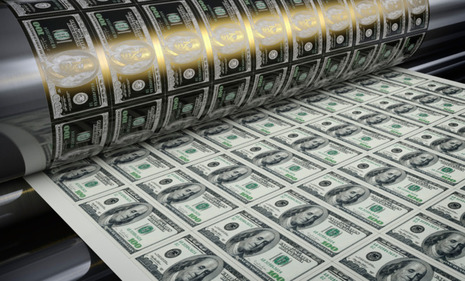
In October the producer price index sank 2.8%, its biggest one-month drop since the Labor Department began measuring it in 1947. At the same time, the Consumer Price Index fell by 1%. It’s no surprise that everyone in the U.S. is talking about deflation. Indeed, the bond market is pricing in deflation. The fact that the yield on five-year Treasurys with no inflation adjustment is 2% while that on five-year Treasury inflation-protected securities is 2.4% implies that the bond market expects annual average inflation to be a negative 0.4%.
That’s an objective, market-based forecast, but I think it’s wrong. Yes, the deleveraging of the economy has set loose deflationary forces. However, the Fed has put the money pump into overdrive, and it is hard to see any way in which deflation could be a headline-grabber for many more months, let alone five years. U.S. Treasury-indexed securities remain a buy.
Deflation isn’t on everyone’s mind, however. Zimbabwe’s suffering citizens are caught up in the 21st century’s first hyperinflation. In March 2007 Zimbabwe’s inflation rate passed 50% a month, a good threshold for defining “hyperinflation” and equal to 12,875% a year. Since then, it’s gotten much worse.
The cause of the hyperinflation is a government that forces the Reserve Bank of Zimbabwe to print money. The government finances its spending by issuing debt that the RBZ must purchase with new Zimbabwe dollars. The bank also produces jobs, at the expense of every Zimbabwean who uses money. Between 2001 and 2007 its staff grew by 120%, from 618 to 1,360 employees, the largest increase in any central bank in the world. Still, the bank doesn’t produce accurate, timely data.
The last official inflation statistics, for July, are hopelessly outdated. Money-supply data are even worse; the most recent figures are for January 2008—ancient history.
In the absence of good official numbers, I’ve developed my own hyperinflation index for Zimbabwe. I derive it from market based price data starting in January 2007. The index tells us that Zimbabwe’s inflation rate recently peaked at 80 billion percent a month. That means around 6.5 quindecillion novemdecillion percent a year—or 65 followed by 107 zeros. To get a handle on it, realize that it’s equivalent to inflation of 98% a day. Prices double every 24.7 hours. Shops have simply stopped accepting Zimbabwean dollars.
Where does this place Zimbabwe in the hyperinflation record books? Episodes of true hyperinflation are rare. They occur only when the money supply has been fed by an unconstrained printing press. No hyperinflation has ever been recorded when money was based on or convertible into a commodity. The first hyperinflation happened during the French Revolution. There were 28 other hyperinflations before Zimbabwe’s, all in the 20th century.

The U.S. has had none of them. It came closest during the Revolutionary War, when it churned out Continental currency to pay the bills. The peak monthly inflation rate then was 47.4%, in November 1779. During the Civil War greenbacks were printed to finance the fighting, and inflation peaked in March 1864 at a monthly rate of 40%.
The accompanying table shows the six all time worst hyperinflations. The famous German episode was only the fourth most virulent. It wasn’t even close to the Yugoslav experience under Slobodan Milosevic. Mugabe’s mess now tops Yugoslavia’s, and if it continues to grow at its current rate, it will overtake Hungary’s world record in little more than a month.
Many think this will be the blow that finally topples Mugabe’s 28-year dictatorship. Don’t count on it. Yugoslavia’s hyperinflation peaked in January 1994, but Yugoslavs suffered for nearly seven more years of high inflation until Milosevic reluctantly conceded defeat after the September 2000 elections. Bet on seeing Mugabe stick around for a while yet, unless old age (he’s 84) or assassination gets him. Also bet on a return to at least mild inflation for the U.S.
Author Steve H. Hanke

0 responses on "The Printing Press"